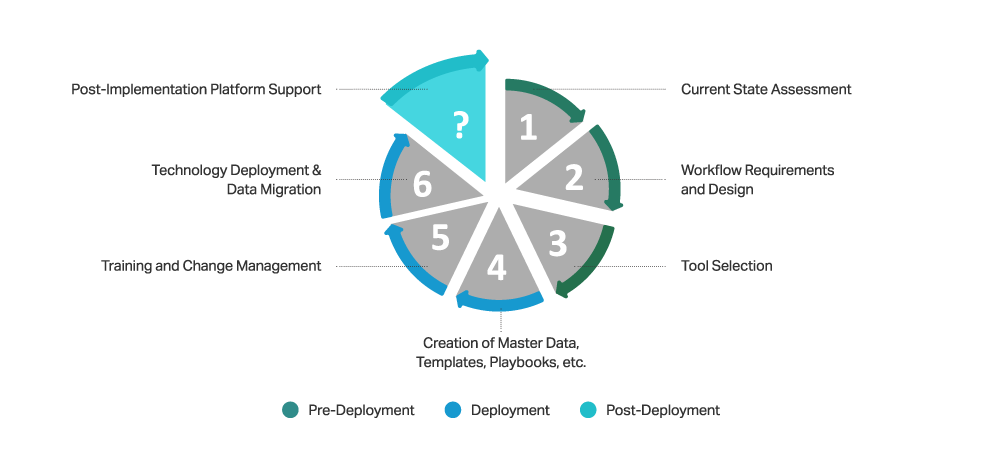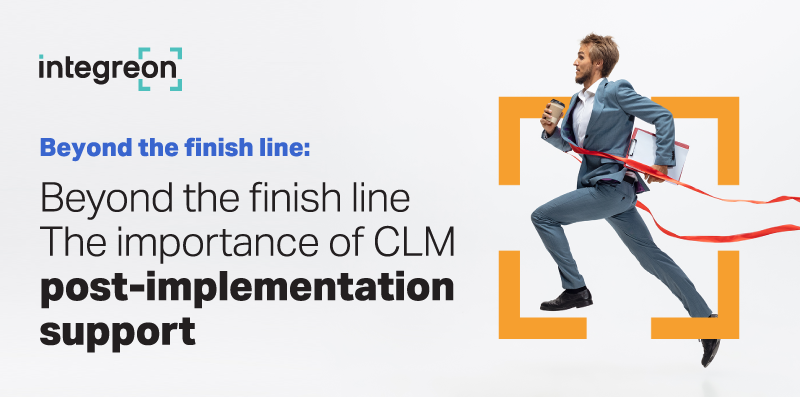Contract Lifecycle Management (CLM) systems have become essential tools for corporate law departments seeking to reap the benefits of digital transformation. CLM technology can streamline the entire contract process—from creation through execution and beyond—while improving compliance and generating actionable insights. Yet many CLM implementations fall short of expectations as organizations struggle to realize the full value of their technology investment.
In this paper, a panel of corporate contract experts explored the factors impacting CLM success and why investing in post-implementation support is essential to maximize the return on a CLM investment and ensure long-term success.
The CLM Success Journey
Deploying a new CLM system is a major undertaking involving careful planning and follow-through. To be successful, CLM implementation encompasses three phases, beginning long before the technology is selected and continues beyond launch as the tool evolves to support the organization.

However, CLM project teams often focus on the pre-deployment and deployment phases, without paying sufficient attention to postimplementation platform support. Indeed, many organizations view the process of launching the new system as “the finish line” in their race to digitize contract processes. In reality, it is just the beginning.
CLM Adoption Challenges
Despite pre-deployment planning, CLM user adoption can be negatively impacted by a range of factors, including:
- Failure to pre-cleanse data before migration
- Training lacking detail and process explanations
- Too many features introduced at once making adoption complex
- Reporting needs not aligned with management expectations and tool capabilities
- Too tight an implementation timeline
- Insufficient vendor support
Any or all of these factors can lead to poor user adoption. Tina Czepiel, Vice President of Legal for Validae Health, recounted her experience where a new CLM system that worked in the development environment fell short after launch. “We had a big rollout and then when team members started using the system nothing worked. So right from the start there was very poor adoption. People refused to use the system.”
Uploading legacy contract data is another common challenge. Czepiel says that she provided the CLM vendor with the company’s legacy data to upload to the system. “This was my first CLM project, so I did not fully realize the importance of cleaning the data and providing the right metadata. This upfront issue continued to cause problems down the line,” she says, noting that several months after launch, she brought in Integreon to help get the project back on track. “Having Integreon there to hold users’ hands through the process was invaluable.”
Douglas Martin, Executive Director of Legal and Compliance Innovation for Morgan Stanley, agreed on the importance of personalized support. “That includes making sure each ticket is followed up on, that training is detailed and customized to specific processes.”
Introducing too many features at once can also hamper success. While CLM is focused on improving end-to-end processes, Martin said that implementation does not have to be an all or nothing proposition. “You can start with one or two phases of the process. Maybe it’s just consolidating multiple contract repositories into one, or using generative AI to help people do contract drafting or redline reviews faster and more accurately. That could be a big win.” Organizations can start small, addressing key process pain points, then build on those successes.
Critical Success Factors
So which best practices are most important for CLM implementation success? The panelists cited a number of important success factors, including:
- Set tool capability expectations with users and management
- Provide written guides and cheat sheets post-deployment training
- Train “super users” to support teams
- Document with vendor what data the tool captures and align to required reports
- Implement “office hours” or a help desk line to answer questions
- Understand leadership and business client reporting requirements
Czepiel said training “super users” and providing cheat sheets were key success factors in her experience. However, she cautioned that busy professionals don’t always have time to review written guides. “So recently, we’ve developed just-intime videos. Right before a user takes an action, they can view a video that takes them through each step of the process. That’s been working very well.”
Martin echoed the value of using digital adoption tools. “We have found that interactive walk throughs that provide training right within the application are very effective.” He added that these tools can be tailored to provide guidance that is specific to company processes and policies. “For example, we added a pop-up right in our CLM tool to provide information on our company’s policy around PII (personal identifiable information).”
Panelists pointed to effective reporting as a key success factor for a CLM deployment. “Reporting feeds adoption. If you don’t have good reports that enable managers to hold their teams accountable for how the tool is working, then adoption falls apart,” said Diane Homolak, Vice President of Technology Solutions for Integreon.
“Reporting is one of the main things we are trying to get from a CLM,” Martin said. “Even if the reporting data isn’t perfect, we can use it to refine the tool to make sure we’re getting the data we need.”
On-demand support surfaced as another critical success factor. “We need to remember that users are adopting a new tool in addition to their day-to-day jobs. So having someone the user can call or do a chat with so they can explain the specific issue or question they have and get customized support can be critical to alleviate their frustration and win them back to using the tool,” explained Patricia Callejon, Director of CLM Strategy and Solutions for Integreon. She noted that this support function is also crucial for gathering user feedback to help improve training materials and guidance tools.
Czepiel noted that designing the system in ways that effectively force people to use it, such as linking it as a required process for issuing a purchase order, can be effective. “People are now getting used to the system so they are becoming more comfortable with it.” Martin agreed with the approach of having steps that require use of the CLM, but noted that it’s important not to build too many of these blocks, which could make the contract process longer.
Sometimes, the issue hampering CLM adoption is the complexity of the contract process itself. “If your cheat sheet is four pages long, something’s wrong with your process,” noted Homolak. Martin agreed, noting that simply applying offline processes to a new CLM tool can be a recipe for frustration. “It’s worth investing the time to clean up your processes, your data and your templates.”
Post-Implementation Support
A key CLM success factor ensuring that post-implementation activities are adequately supported by a named team or individual in the organization. These activities include:
- User access enrollment and permissions management
- Report design, generation, and analysis
- On-going process assessment and improvement
- Tool and template configuration and updates
- Data quality, capture, and integrity
- New feature release testing and training
Organizations that lack support for any of these postimplementation activities will likely struggle to derive value from their CLM system. Having a trusted partner organization supporting some or all of these activities can be critical, Czepiel said.
“There’s only so much I can do in a regular day while handling my other responsibilities. Having a partner like Integreon has helped everything run smoother and make everything more manageable,” she explained.
A CLM system often involves multiple departments with varying processes, adding to the complexity of support. “Once we realized we were going to have multiple implementations with different contract lifecycles across multiple departments, we realized we needed to establish a support operational group for both help desk and system administration. For that, we turned to Integreon and they’ve been a great partner,” Martin explained.
Since modern CLM systems are SaaS applications, vendors are continually introducing new features and capabilities. It’s important to keep track of upcoming enhancements to ensure they don’t disrupt established processes. Testing and training on new releases should involve stakeholders at all levels to ensure new functions are useful.
Using reports to drive process improvement is a key factor for CLM success and user adoption. While many organizations have analytics departments, Martin emphasized the Tina S. Czepiel Vice President Legal Contracting Validae Health Douglas Martin Executive Director importance of developing actionable reports. “You really need to have people involved who understand the specific processes and what success looks like in order to get meaningful KPIs (key performance indicators) and OKRs (objectives and key results).”
For example, to evaluate adoption, it’s important to gather and review data on who is actually using the system. “We have seen situations where a company is paying for a certain number of licenses, but are all those people with access actually using the tool? If people aren’t using it, it could be a process issue or not having the right template to do their work, or some other issue,” Callejon noted. “It’s important to have reporting to identify and resolve these issues.”
Go-Live is Just the Beginning
While pre-implementation planning is important, “it’s never too late to achieve success,” Callejon said. “Even if you had some misses following deployment, post-implementation is a good opportunity to get back on track.”
Choosing a trusted support partner can be extremely beneficial—and the best time to engage a postimplementation partner is early in the process. An experienced partner can help you select the right CLM solution to meet your organization’s needs. And they can help develop training and reference tools based on best practices honed over many implementations to help drive adoption.
The right partner can help drive continuous improvement by establishing a robust process for tracking progress and gathering user feedback. Paying close attention to user feedback and behavior is important to identify areas that need refinement. By combining data-driven analysis with ongoing user engagement, you can ensure that your CLM system evolves to meet your organization’s needs, ultimately enhancing efficiency and maximizing the return on your investment.
“Assume that go-live is just the beginning of your CLM journey,” Martin advises. “Continually track your progress and celebrate small wins.”

